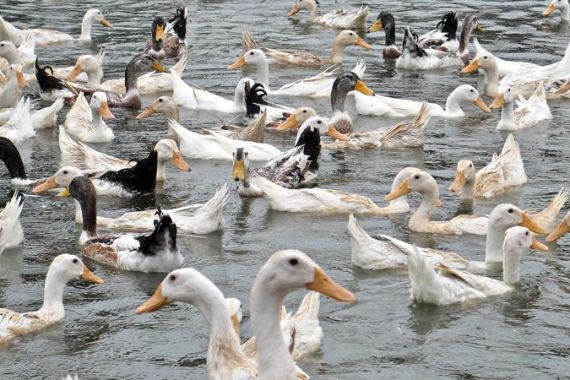Bird flu a ‘fact of life’ in Vietnam
Vaccination and disinfection are as much a part of the routine as herding, feeding and egg collection at duck farms.

As the apartments and factories on the now sprawling outskirts of Hanoi give way to a more rural landscape of lush green rice fields dotted with ancient temples, ducks swim and forage in the watery fields and potter about in groups on the banks. This is the region known as Van Dinh, famous for producing some of the north’s tastiest ducks.
Like many other areas across the Mekong Delta, villagers here traditionally let their ducks roam free. Flocks mix freely, scavenging for snails and weeds in paddy fields, rivers and ponds during the day and returning to their farms in the evening. It’s a way of life that’s persisted for generations, steeped in the traditions of the rice harvest. But the outbreak of the H5N1 virus, more commonly known as bird flu, which started nearly a decade ago is changing old habits.
Duong Van Bon’s family has been in the poultry business for three decades. Like his neighbours, Bon used to farm ducks and chickens the traditional way. But having seen the devastation caused by bird flu, he now raises his flocks in proper enclosures with their own pond a fenced-off part of the village lake.
It’s a medium-sized farm by Vietnamese standards 1,000 ducks and 200 chickens producing some 800 eggs a day. The simple buildings, constructed out of bamboo and cement, provide shelter for the birds and a place for them to lay the eggs that are highly prized in Vietnamese cooking. Eventually the ducks will be sold for their meat.
Bon has taken full advantage of government funds to vaccinate his birds against the virus and disinfects his farm with pesticide on a regular basis.
But while his farm’s managed to avoid infection, Bon admits he’s nervous about a new strain of bird flu that was first detected in August and has spread rapidly through the country. The government describes the new strain as “highly toxic”. It kills every chicken it infects, normally within four days. Ducks have more resistance., but many of them succumb too.
In a modest laboratory at Hanoi’s National Centre for Veterinary Diagnosis, researchers are trying to find out why working out how this strain of the virus is different and whether existing vaccines are effective against it. Early findings suggest the existing vaccines will be sufficient but the final results won’t be available until October at the earliest.
Evidence suggests the mutation came from outside Vietnam.
“Usually a virus can evolve locally but looking at the genetic data it’s not a local evolution,” said Nguyen Tung, vice-director of the centre. “It comes from outside.”
China is the prime suspect. It shares a 1,300km border with Vietnam and smuggling, even of birds and poultry, is common.
Wherever the latest mutation originated, Vietnam has learned lessons about how best to deal with the violence since the first outbreak.
“In 2004, the virus was galloping around with gay abandon,” said Laurie Gleeson of the UN’s Food and Agriculture Emergency Centre for Transboundary Animal Disease. “Now the government’s veterinary services have become better at controlling the disease and the improvement after vaccination was fairly dramatic.”
Since discovering the new strain, Vietnam has culled thousands of birds and stopped the movement of poultry in affected areas. Gleeson, who’s monitored bird flu since it first appeared in the country, thinks this latest outbreak will settle down. But with the disease now seen as endemic, he says bird flu is now a “fact of life” for Vietnam.
Back in the duck farming villages of Van Dinh, vaccination and disinfection are now as much a part of the farming routine as herding, feeding and egg collection. Bon gets about $5,000 a year from his ducks a sizeable amount in a country where the average annual income is just over $1,000. Bird flu may not ever be beaten, but with so many livelihoods at stake Vietnam is keen to make sure it remains well contained.